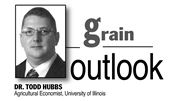Large Corn and Soybean Yield Forecasts Hurt Price Prospects

The USDA August Crop Production report contained larger than expected forecasts for the 2018 U.S. corn and soybean crops. At 178.4 bushels per acre and 51.6 bushels per acre respectively, the corn and soybean yields came in above trade expectations. The larger than expected production levels for both crops sent harvest futures prices tumbling lower.
The soybean crop forecast of 4.586 billion bushels is 179 million bushels larger than the average trade guess. The USDA made no changes to the 88.9 million harvested acres from the June Acreage report for soybeans. The U.S. average soybean yield forecast of 51.6 was two bushels larger than trade expectations. Yield forecasts in many states across the Corn Belt reflected the excellent crop condition ratings this summer. Iowa (59 bushels per acre) and Illinois (64) yield forecasts came in up 2.5 and 6 bushels per acre from last year respectively. States in the Mid-South region produced excellent soybean yields as well. Mississippi and Alabama reported record yields of 53 and 48 bushels per acre respectively. Over the last decade, the USDA August yield forecast has been lower than the final national soybean yield estimate only three times. The USDA has not produced an August soybean yield forecast greater than one bushel above the final soybean yield since 2003.
For old crop soybeans, the USDA increased the soybean crush projection by 10 million bushels to 2.04 billion bushels and increased exports by 25 million bushels to 2.11 billion bushels. The pace of domestic crush and exports currently suggests these projections will hold for this marketing year. The forecast of ending stocks for the current marketing year decreased by 35 million bushels to 430 million bushels.
Forecasts for the 2018-19 marketing year increased ending stocks by 205 million bushels to 785 on the larger than expected production levels. The forecast for domestic soybean crush increased 15 million bushels to 2.06 billion bushels. Soybean export forecasts increased 20 million bushels reflecting recent strength in soybean exports. The forecast for the marketing year average price decreased by 35 cents to a range of $7.65 – $10.15. The potential for lower soybean consumption than current USDA forecasts for 2018-19 is dependent on trade issues over the next year. Soybean exports will depend on continued growth in soybean imports to non-Chinese sources. The potential for South American soybean production to come in 700 million bushels larger than the last crop seems likely. When combined with the current soybean production levels in the U.S. and continuing trade issues, average farm prices for soybean appear set to be in the lower end of the current USDA price range.
For corn, the USDA made no changes to the 81.8 million harvested acres from the June Acreage report. The U.S. average corn yield forecast of 178.4 was 2.2 bushels larger than trade expectations. The projected corn crop is 175 million bushels larger than the average trade guess at 14.586 billion bushels. As expected due to strong crop condition ratings, the eastern Corn Belt and Plains states yield projections came in at high levels. Illinois (207 bushels per acre), Ohio (180), Nebraska (196), and South Dakota (170) corn yield forecasts currently come in at record yield levels for each state. The poor crop conditions in Missouri resulted in a 39 bushel reduction from last year to 131 bushels per acre. Current field conditions in many regions, including numerous reports of tip-back issues, give a slight indication that the yield projection may not see growth as we move toward harvest. In the last ten years, USDA’s August yield forecast came in below and above the final yield estimate five times each.
Old crop year ending stocks estimates came in at 2.027 billion bushels, which is unchanged from the July estimate. USDA forecasts for corn consumption categories during the 2017-18 marketing year reported no changes from July. Corn exports continue to show strength and may exceed the current projection of 2.4 billion bushels. Feed and residual use is still uncertain with 754 million bushels necessary to meet the projection of 5.45 billion bushels. An expectation of ending stocks for the current marketing year near the present projection is reasonable and likely at this point.
For the 2018-19 marketing year, the USDA increased corn feed and residual use and exports by 100 and 125 million bushels respectively. Projection of corn used for ethanol remained at 5.625 billion bushels. Stocks on September 1, 2019 are projected at 1.684 billion bushels and the average farm price for the year ahead is forecast in a range of $3.10 to $4.10, down 20 cents from the July report. Given the current production potential and recent strength in corn exports, an expectation of stronger export levels for the next marketing year seems prudent. The possibility for slightly higher corn use in ethanol exists due to strong ethanol exports and a slight uptick in gasoline consumption in 2018-19. Overall, the continuation of strong corn consumption combined with even a moderately lower yield would place prices at the higher end of the current USDA price range.
The USDA corn and soybean production forecasts will be updated on September 12. Uncertainty remains for U.S. average corn and soybean yield forecasts. For soybeans, in particular, August weather will be a deciding factor. Prices will reflect crop production potential and trade issues as we move into the harvest period. ∆
DR. TODD HUBBS: Agricultural Economist, University of Illinois